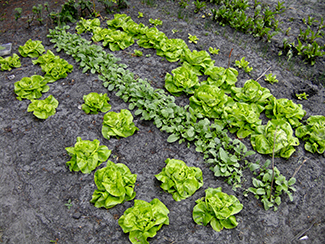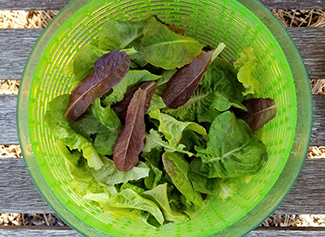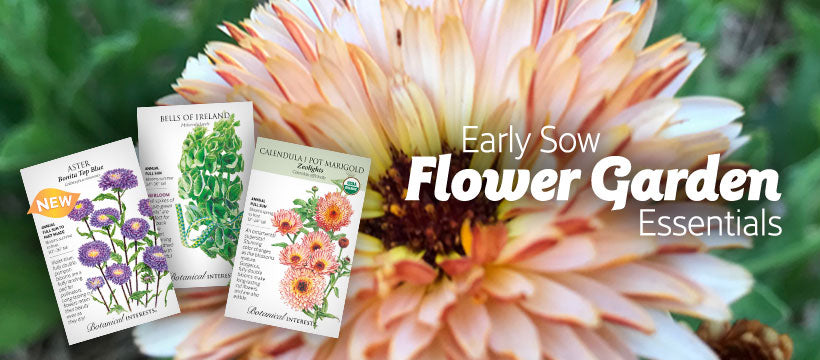For a lot of us, lettuce is a staple. Summer is built on a bowl full of lettuce greens, and in our opinion, no sandwich should be without that familiar crunch. With a little know-how, you can have an abundance of lettuce at your fingertips for a lot of the year. If you were wondering how to grow lettuce from seed, you've come to the right place!
There are five primary types of lettuce: BUTTERHEAD: Also called Boston or Bibb lettuce, its soft, slightly crumpled light green leaves form in a loose head, often with a creamy yellow core. CRISPHEAD: Commonly called iceberg or head lettuce, the leaves are crisp and tightly wrapped into a dense head. LEAF: Heads are open rather than tight. Leaves can be green, red, or green with red tips and are soft with a crisp rib. ROMAINE (COS): Upright, medium to dark green, red, or green and red leaves with broad, stiff ribs and lighter green, very crisp heart. SUMMER CRISP: Also called Batavia or French Crisp, it has crisp and sweet, open, loose leaf plants that develop into a denser bunch or a head.
GENERAL SOWING

When to sow outside: RECOMMENDED. 2 to 4 weeks before your average last frost date, and when soil temperature is at least 40°F, ideally 60°-70°F. Successive Sowings: Every 3 weeks until 4 to 6 weeks before your average first fall frost date for head lettuce. Mild Climates: Sow in fall and winter for cool-season harvests.
When to start inside: 4 to 6 weeks before your average last frost date, and in summer when soil temperatures are too warm (above 80°F) to germinate lettuce seed.
Special germination instructions: Soil temperatures over 80°F greatly reduce the germination rate. In hot summer areas, start successions indoors; outdoors use a shade cloth to cool soil.
How many do I plant?
How many heads of lettuce do you usually go through in a week? Sow about 3 times this much so that between successions you will have enough lettuce on hand in the garden to enjoy.
INDOOR SOWING
Use a lightweight seed starting mix/medium (sterile, and lighter than potting mix), and sow seeds on the surface to 1/8" deep. Sow 3 seeds per pot, thinning to the strongest plant once leaves appear. Clip extra plants at the soil level using scissors instead of pulling them so you don't disturb the neighboring plants. The strongest plant may not be the tallest; look for thick, strong stems and deep color. By thinning early, you minimize the negative impact of crowding, like stretching for light. Read about more indoor sowing tips.

Containers
Use clean, sanitized containers with drainage. Lettuce won't need much root space between the time you sow and transplant. 1½" recycled paper pots work well and so do traditional 4- or 6-cell packs.
Transplanting
Once seedlings are about 4 weeks old and are acclimated by hardening off, transplant them into the garden at the recommended spacing noted on your seed packet. A fertilization with kelp or seaweed beforehand can help seedlings with transplant stress. Be sure to water seedlings well, right after transplanting, and for several days following. Lettuce has shallow roots which makes it a bit more susceptible to drying out when its roots grow into the new soil.
OUTDOOR SOWING

Sowing or transplanting preparation and spacing
Prepare beds ahead of time. Lettuce is a fairly heavy feeder so be sure the garden is rich with nitrogen. Nitrogen is the most fluid macronutrient in the soil and it gets gobbled up by vegetables and moves around in the soil water and even turns to gas. If you gardened in this area last year and didn't grow a cover crop it is likely that adding some nitrogen-rich amendments like compost or manure would help. Consult the back of your seed packet for the ideal spacing for that cultivar.
Weeding
Cultivate shallowly, as lettuce roots are shallow and can be harmed.
Fertilization
If additional nutrients are needed, apply a balanced fertilizer (equal parts nitrogen, phosphorus, and potassium) or nitrogen-rich, liquid fertilizer regularly after plants have true leaves.
Water
Keep moist but not soggy; drought stress can cause bitterness and bolting.
Special Care
Mulching around plants keeps the soil more evenly moist and roots cooler, which helps prevent bolting.HARVESTING
Harvest in the morning by cutting off at ground level. If regrowth is desired, cut the leaves higher, at 2". For a continual supply, outer, individual leaves can be harvested at any stage of maturity, but leave at least half of the plant for regrowth. Rinse if needed in cool water, dry, and store in a sealed container in the vegetable drawer of the refrigerator for up to 2 weeks.
COMMON PESTS AND DISEASES

Slugs feed primarily on tender plant tissue. They rasp large holes in foliage, stems, and bulbs and may destroy seedlings. They are most abundant and damaging during wet weather and in high rainfall regions. To encourage the many natural predators of slugs (ground beetles, fireflies, birds, garter snakes, toads, and lizards), maintain permanent walkways of clover, sod, or stone mulches. Use copper flashing as edging for garden beds. Protect seedlings by spreading wide bands of cinders, wood ashes, or diatomaceous earth along rows (renew frequently). Trap slugs under pots, boards, or grapefruit rinds; collect and destroy every morning. Make traps by burying a cup or can with the lip flush to the soil surface; fill with beer or other fermenting liquids.


